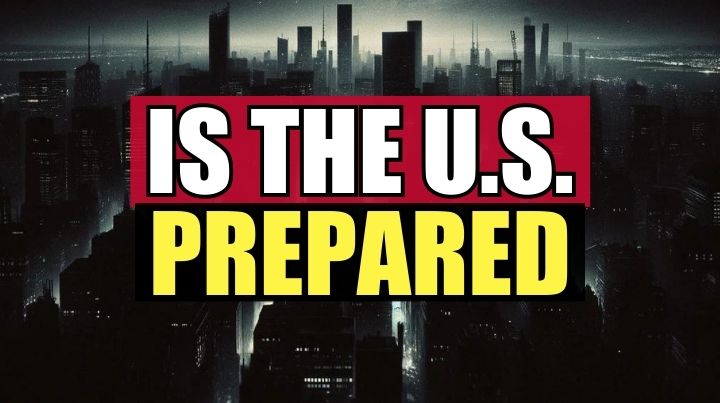What is an EMP? The Expert Guide to Electromagnetic Pulses!

In today’s digital age, the threat of Electromagnetic Pulses (EMPs) may seem like fiction, but it’s a genuine danger. Triggered by nuclear blasts high above the Earth, EMPs can instantly plunge modern society into chaos by damaging or destroying electronics. Everything from smartphones to essential infrastructure becomes vulnerable.
Scientists identified EMPs’ potential in the 1950s, and as our reliance on technology grows, so does our vulnerability. With governmental efforts to mitigate risks, the question remains: how prepared are we for this potentially catastrophic event?
This article, based on an interview with Dr. Arthur Bradley, a renowned EMP expert, dives into the science, historical context, and readiness measures regarding EMPs. Bradley’s insights, drawn from military, engineering, and NASA experience, shed light on this complex EMP threat and the importance of preparation.
Join us as we explore the intricacies of EMPs and the critical need for readiness in the face of this invisible yet significant peril.
Watch This Five Minute “What is an EMP” Video
What Does EMP Mean?
An Electromagnetic Pulse (EMP) is a sudden burst of electromagnetic energy resulting from a nuclear explosion in the atmosphere. Upon reaching the Earth’s surface, this pulse can disrupt and damage electronic devices. The more modern the electronics, the greater their susceptibility to damage from the EMP.
Are Electromagnetic Pulses Real?
The first question regarding EMPs is whether or not they are real. Despite what some people, including elected U.S. Congressmen, might have us believe, there is such a thing as an Electromagnetic Pulse. The only debate regarding EMPs is the extent of the damage they can cause.

Historical Context and Discovery of EMP effects
While Scientists predicted EMPs, they did not become a known reality until conducting nuclear test experiments in the 1950s. As atomic testing escalated between the United States and Russia in the 1960s, people began to realize that the electromagnetic pulses were more potent than the predictions.
The realization about the extent of damage from a nuclear electromagnetic pulse came during atomic tests such as Starfish Prime when nuclear bombs detonated out over the Pacific and caused damage to electrical systems and communications infrastructure hundreds of miles away in Hawaii.
The Science Behind an Electromagnetic Pulse
An electromagnetic pulse happens when detonating a high-altitude nuclear warhead. It generates a very broad band, meaning it has a lot of electromagnetic radiation energy frequencies.
The pulse waveform energy travels from the nuclear explosion to the Earth’s surface, couples into conductors (wires of any sort), and then flows to semiconductor devices and digital electronic circuitry, causing damage to them. The longer the conductors, such as power lines, are, the more likely they are to pull energy into the attached electronic systems and their electrical components.
Potential Damages from EMPs
An EMP has the potential to damage electronic equipment. However, there’s much debate over exactly what would happen if a full-power EMP were to detonate over the United States.
The Pessimistic Outlook on Electromagnetic Pulse Damage
Some people predict that an EMP would be “the end of the world as we know it” (TEOTWAWKI). The more pessimistic people believe an EMP will result in a total power grid failure. They often state that the magnetic field will destroy the grid’s large transformers, which are expensive, hard to make, and extremely difficult to replace. As the EMP Commission concluded, the United States could be without power for up to a year in that scenario.
The Optimistic Outlook on Electromagnetic Pulse Damage
Even in an optimistic scenario, an EMP would be unlike any catastrophe we’ve ever experienced. A nuclear EMP would shut down millions of vehicles. It would cause trillions of dollars of damage to the country. It would be a massive problem.
Whether or not it killed everybody due to the side effects of not having food, water, and electricity is open to debate. However, what is not open to debate is that it would undoubtedly disrupt a lot of critical infrastructure sectors and millions of lives along with it.
Government and Military Perspectives on EMPs
The government and the military have known about EMPs since the 1950s. When it comes to EMPs, the United States is not the only country with EMP weapons. While we can detonate an EMP over Russia or China, they have the nuclear weapons capability to do the same thing to the U.S. Therefore, no one is safe from the potential of an electromagnetic pulse attack.
There’s Very Little That Can Be Done to Stop an EMP
Because EMP weapons are detonated high up in the atmosphere, approximately 300 miles or more, they are nearly impossible to destroy. Therefore, if an adversary launches a high-altitude EMP, the nuclear weapon will detonate and cause an EMP. Unfortunately, there’s not much that can be done other than hardening our systems.

How Prepared Is the U.S. for an EMP?
According to Dr Bradley, the United States, like most countries, hasn’t taken preparation for an electromagnetic pulse attack very seriously. That’s in spite of the fact that Congress conducted an EMP Commission, which investigated EMPs and came up with some pretty scary conclusions and strong recommendations. Unfortunately, most recommendations have not been followed because of the expense of hardening infrastructure against EMPs.
Hardening our grid is more difficult than most people realize because it is extremely complicated. Part of the problem is that our grid and critical infrastructure are made up of hundreds of different utility-related companies that all have a hand in different aspects of the situation. Because of that, our society’s commercial and industrial side has never been hardened against the effects of an electromagnetic wave. As such, we are very susceptible to an electromagnetic pulse EMP.
How Prepared is the Military for an Electromagnetic Pulse
Our military is probably better off than the civilian sector. That’s because the military tests its hardware for the ability to withstand electromagnetic pulses. For example, before satellites are launched into space, they test their survivability against EMPs.
So, despite many people believing that every satellite is going to get destroyed when an EMP detonates, that’s unlikely. If an EMP occurred in space, it would take some things down, but many would survive and continue functioning.
The Bottom Line on EMPs
Knowing about EMPs is crucial in a world that depends heavily on electronics. Dr. Bradley’s advice shows that because our society is unprepared for an EMP, we, as individuals and communities, need strong plans to handle the fallout if one hits. With EMPs being a real threat, it’s essential to take steps to protect ourselves and our communities from their effects.
What are your thoughts on EMPs? Are you ready? What do most people get wrong when preparing for an EMP attack? Tell us in the comments below.
Additional Resources:
- EMP Truth: What You ACTUALLY Need to Know! (Video)
- Dr. Arthur Bradley’s Website: Disaster Preparer
- Top Prepping Tips! (Step-By-Step Survival Guide)
Stay safe,

Don't Miss Out!
Join the thousands of people who rely on Mind4Survival preparedness advice by subscribing to our FREE newsletter.
- Practical preparedness information
- Zero Spam
- < 0.25% of people unsubscribe




Join Mind4Survival!
Stay informed by joining the Mind4Survival! 100% Secure! 0% Spam!
Follow Us!
Affiliate Disclosure
Mind4Survival is a free, reader-supported information resource. If you make a purchase through our link, we may, at no cost to you, receive an affiliate commission.


